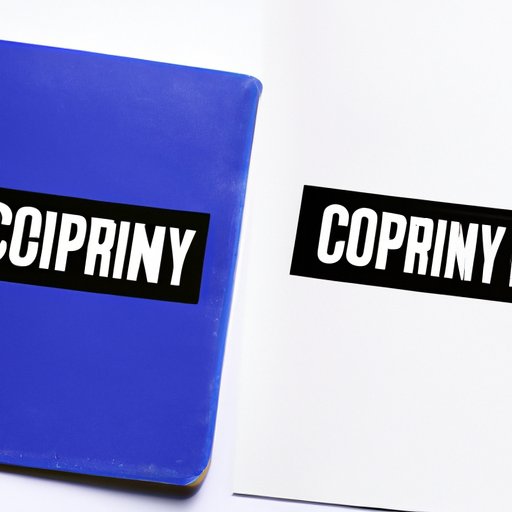
I. Introduction
As a creator, protecting your original work is crucial. Copyright laws are in place to ensure that your creative ideas are protected from infringement. This article will guide you through the process of understanding copyright laws, registering your copyright, and protecting your work from infringement.
II. Understanding Copyright Laws
Copyright refers to a set of legal rights granted to authors of original works. This includes literary, musical, artistic, and other creative expressions. The purpose of copyright laws is to safeguard the rights of creators and provide them with the exclusive right to distribute, reproduce, and perform their works.
Works that can be copyrighted include books, music, photographs, paintings, and other original creative works. It’s important to note that copyright does not protect ideas, concepts, or methods.
The duration of a copyright varies depending on the type of work, but generally, it lasts for the lifetime of the author and an additional 70 years. During this time, the copyright owner has the exclusive right to use and distribute the work.
As a copyright owner, you also have the right to prevent others from using, copying, or distributing your work without your permission. Examples of copyright infringement include using a copyrighted photograph in a commercial ad without permission or publishing a copyrighted article without giving proper credit.
III. Steps for Registering a Copyright
Registering your copyright is not required, but it puts others on notice that you are the rightful owner of the work in question.
The first step is to visit the U.S. Copyright Office’s website and fill out the relevant registration form. You will need to provide a copy of the work in question and pay a fee. The fee varies depending on the type of work and how it’s being registered.
The registration process can take several months, so it’s important to submit your application well in advance of any deadlines or publication dates.
When registering your copyright, it’s important to keep good records and track any instances of your work being used without your permission. This will make it easier to build a strong case in the event of infringement.
IV. Strategies for Protecting Original Works
Even if you’ve registered your copyright, it’s still possible for others to copy or plagiarize your work. To protect your work, it’s important to take proactive steps.
One of the best ways to protect your work is to place a copyright notice on it. This lets others know that you hold the copyright to the work and that it’s not to be used without your permission.
You can also use technological tools such as watermarks or digital tracking to deter infringement. These tools make it easier to trace the source of the infringement and build a strong case against the infringer.
V. Copyright Infringement: What It Is and How to Avoid It
It’s easy to infringe on someone’s copyright without even realizing it. Common examples include using copyrighted images in blog posts without permission or using copyrighted music in a video without proper licensing.
To avoid copyright infringement, it’s important to do your due diligence. Always check to see if a work is copyrighted before using it and obtain proper permissions or licenses before use.
If you do infringe on someone else’s copyright, there could be serious consequences. Penalties for infringement include fines, legal fees, and in some cases, criminal charges.
VI. The Role of Copyright in the Digital Age
You may be wondering how the rise of digital technology has impacted copyright laws. One of the main challenges in the digital age is file sharing. The ease of digital file sharing has made it much easier for others to copy and distribute copyrighted works without permission.
Creative commons licenses have emerged as a way for copyright owners to allow others to use their work while still maintaining some control over it. These licenses offer different degrees of freedom in terms of how the work can be used.
Streaming services have also posed challenges for copyright holders. Services such as Netflix and Spotify must obtain proper licensing agreements to use copyrighted works, which can be complex and time-consuming.
VII. Exploring Copyright Alternatives
For some creators, traditional copyright laws may not provide the best solution. Copyleft is an alternative solution that essentially creates a “share-alike” model. This means that others can use and distribute your work freely as long as they also make their derivative works available under the same conditions.
The public domain mark is another alternative that allows creators to release their work into the public domain. This means that anyone can use and distribute the work without restrictions or the need for permission.
While these alternatives can offer benefits, it’s important to weigh the pros and cons carefully before making a decision.
VIII. Copyright and Fair Use
Finally, it’s important to understand the concept of fair use. Fair use allows for limited use of copyrighted material for certain purposes, such as criticism, commentary, news reporting, teaching, scholarship, or research.
It’s important to note that fair use is not a blanket permission to use copyrighted work. The four factors of fair use that are considered when determining whether a particular use is fair include the purpose and character of the use, the nature of the copyrighted work, the amount and substantiality of the portion used, and the effect on the market for the original work.
When in doubt, it’s always best to obtain permission from the copyright holder before using their work.
IX. Conclusion
Copyright laws are in place to protect the rights of creators. By understanding these laws, registering your copyright, and taking proactive steps to protect your work, you can safeguard your creative ideas from infringement. Remember to always do your due diligence and obtain proper permissions or licenses when using the work of others.




